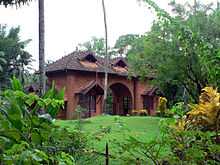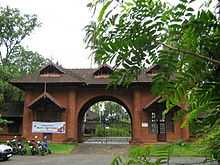Thunchaththu Ezhuthachan
| Thunchathu Ramanujan Ezhuthachan | |
|---|---|
 | |
| Born |
c. 1495 Thunjan Parambu, Trikkantiyur, Vettathunad (now part of Malappuram, Kerala, India) |
| Died | c. 1575 |
| Occupation | Poet, teacher |
| Language | Malayalam |
| Nationality | Vettathunad |
Thunchaththu Ramanujan Ezhuthachan (Malayalam: തുഞ്ചത്ത് രാമാനുജൻ എഴുത്തച്ഛൻ, tuñcattŭ rāmānujan eḻuttacchan) was an Indian poet from around the 16th century (c. 1495-1575 AD according to historian Ulloor S. Parameswara Iyer). He is known as "The Father Of The Malayalam language" — the principal language of the Indian state of Kerala.[1] He was born in Trikkantiyur, in the town of Tirur, in Vettathunadu.[2] Thunchaththu is his family name, Ramanujan his given name, and Ezhuthachan (schoolmaster) is an honorific title or the last name indicating his caste. His name is transliterated in several ways, including Thunchath Ezhuthachan, Thunchaththu Ezhuthachan, Thunchaththu Ezhuthachchan and Thunjath Ezhuthachan.
Until his time, the Malayalam language had been developing along two different lines without a degree of uniformity of style. The writings of Thunchaththu Ezhuthachan became a confluence of the two channels of linguistic currents. He borrowed from Indo-Aryan Sanskrit its rich lexicography but with a difference: the mainstay of his style in writing verses rested on the indigenous Dravidian Tamil school.
In his time, Vattezhuttu, the abugida writing system originally used to write Tamil, was generally used to write Malayalam. However, Ezhuthachan wrote his Malayalam poems in Arya-ezhuttu (Malayalam script), a Grantha-based script originally used to write Sanskrit, so that he could accurately transliterate Sanskrit words into Malayalam. His works became unprecedentedly popular in Kerala, which in turn popularized the Malayalam script adopted by him.
Circumstances of birth and caste


Thunchaththu Ramanujan Ezhuthachan lived c. 16th century.[3][4] He was born at Trikkantiyur in Vettathunad, a feudal principality around what is now Tirur, Malappuram district, Kerala state, India. His precise birthplace is now known as Thunjan Parambu.
According to Arthur Coke Burnell, he was "a low-caste man who goes under the name Tunjatta Eluttacchan, a native of Trikkaṇḍiyur in the present [1874] district of Malabar. He lived in the seventeenth century, but his real name is forgotten; Tunjatta being his ‘house’ or family-name, and Eluttacchan indicating his caste”.[5] In 1865, Burnell saw the manuscript of the Bhagavata translated and adapted by Thunchaththu, allegedly copied by his sister, preserved at Puzhakkal in the Chittur taluk, and wrote that “The author’s stool, clogs, and staff are preserved in the same place; it thus looks as if Tunjatta Eḻuttaččhan was a sannyâsi of some order.”[6]
Other sources have considered him to be of the Kaniyar caste.[7][8][9] This community of traditional Hindu astrologers were well versed in Sanskrit and Malayalam[10][11] their members in the Malabar region were traditionally known as Ezhuthu Asans or Ezhuthachans, by virtue of their function as village school masters to non-Brahmin pupils.[12] Their unusual flair in Malayalam and Sanskrit language has been noted by many historians during this period.[citation needed]
There are also legends that Ezhuthachan's father was a Nambudiri Brahmin, although there is no evidence for this.[13] Ellis has noted thatA Brahman without a father must be born of an unmarried female of that tribe, whose celibacy ought to have been inviolate: he is considered, therefore, illegitimate, and has scarcely an assignable place in society. Elutt' Achan, or the 'Father of Letters', was a Brahman without a father, and on that account has no patronymic ... The Brahmans envied his genius and are said to have seduced him by the arts of sorcery into the habit of ebriety ... he enriched the Malayalam with the translations, all of which, it is said, he composed under the immediate influence of intoxication.[14][citation needed]
Burnell agreed with Ellis, saying that "Eluttachchan [sic] lived in the 17th century; there is no reason for supposing that he was a Brahman father's illegitimate son; he was certainly an Eluttachchan (or schoolmaster) by caste."[15][citation needed]
The Malayalam poet and historian Ulloor S. Parameswara Iyer concludes Ezhuthachan could be either Chakkala Nair or Vattekattu Nair.[citation needed] K. Balakrishna Kurup said in his book, Viswathinte Kanappurangal, that Ezhuthachan belongs to the Ezhuthachan caste,[citation needed] and this opinion is supported by T. B. Vijayakumar, the historian.[citation needed] Mahakavi Kodungallore Kunhikuttan Thampuran, another poet, agreed.[citation needed]
Father of the Malayalam language
There is no doubt about Thunchaththu Ramanujan Ezhuthachan's vital contribution to the literary level of the common man of medieval Kerala. Ezhuthachan taught his pupils to respect and worship the Malayalam language and the Arya-ezhuttu alphabet. He refined the Malayalam language style and wrote his works for ordinary people, incorporating whatever was good with a strong sense of righteousness and worship. His contribution to the Malayalam language through the Adhyathmaramayanam (a translation of the Ramayana and Mahabharatham (a translation of the Mahabharata) is unparalleled, and his contribution on the cultural level is immense. His chief original works are said to include the:[16]
- Keralolpathi
- Hari Nama Keerthanam (the song of the holy vame "Hari")
- Ganapatistavam
- Kilippatu Prasthanam
- Devi Mahathmayam
- Kerala Natakam
- Harihara Sudham
"...[T]he phrase ‘father of language’ is a symbolic reference. Language represents culture. So Ezhuthachan is in fact denoting culture. He shone as a brilliant star above our culture. He renovated the alphabets of heart. We see the light of conscience and moderation in Ezhuthachan. We call him ‘the father of Malayalam language’ because he led the language to a new dimension."
— Chattanath Achuthanunni, chair, Thunjan Festival meeting (1998)
However, K. N. Ezhuthachan considers that only Adhyatma Ramayanam and Mahabharatham were written by him.[17]
The Malayalam alphabet
Until Ezhuthachan’s time, there were various alphabet systems in use in Kerala:
- Vatteluttu (Vattezhuthu):[18] A 30-letter[19] [citation needed] alphabet which was taught as the Malayalam alphabet by kalaries or schools to the common people.
- Grantha-based alphabet used to write Sanskrit.
- Combinations of the above two, as per Manipravalam.
As the influence of the Sanskrit language upon the Malayalam language increased, the Vattezhuthu alphabet was used commonly to write Sanskrit words and other derivations, though distorted. The names of parts of Vedas like Samhita, Ashtakam, Varggam, Anuvakom were written as changatha, attam, vakkom, anam respectively, in Vattezhuthu. What was written, was not exactly what was read. Works were also written in this way. Vattezhuthu was used with interposition of letters of the Grandhakshara to denote essential Sanskrit phonetics (e.g., in important decrees or shasanas).
It would not have been sufficient to just create a new alphabet set, as it would not have been easily accepted everywhere. Most probably there were different views at that time. The most practical way out was to write a popular Keerthanam (a poetic song) in a standardized alphabet, so that it would be widely used. Ezhuthachan thus composed the Hari Nama Keerthanam in his new 51-character alphabet. Since the song was wildly popular, the alphabet grew in use and popularity along with it. The 31-character Vattezhuthu alphabet continued to be taught as the Malayalam alphabet until the British regulations relating to registration of bonds and deeds eventually led to its disappearance.
It is also believed that Ezhuthachan contributed to the peace and unity of Kerala during a period of political anarchy.[citation needed]
Thunjan Parambu
People from around Kerala come to take sand from the Thunjan Parambu[20] to use in the initiation of their children to the alphabet. Every year, hundreds of people bring their children to Thunjan Parambu to write their first letters during the Vijayadasami festival which falls in the months of October–November. Children are initiated into the world of letters by masters, teachers or parents by holding their fingers and writing the letters in a plate filled with rice. The letters will also be written on their tongues with a golden ring.
They write:
"Anpathoraksharavum oronnithenmozhiyil
Anpodu cherkka Hari Narayanaya Nama" — Hari Nama Keerthanam 14th stanza
See also
References
- ↑ Lewis, M. Paul, ed. (2009), "Malayalam", Ethnologue: Languages of the World (16th ed.), SIL International, retrieved 2009-11-17.
- ↑ "MALAPPURAM Beckons". Public Relations Department, Government of Kerala. Retrieved 2009-11-18.
- ↑ Burnell, Arthur Coke (1874). "Elements of South-Indian Palæography from the Fourth to the Seventeenth Century A.D.". p. 35. Retrieved 2009-11-06.
- ↑ "Thunchathu Ezhuthachan". Information & Public Relations Department, Government of Kerala. Retrieved 2009-10-29.
- ↑ Burnell (1874), p. 35.
- ↑ Burnell (1874), p. 36 footnote 1.
- ↑ "Article about Tunjath Ezhutachan's caste".
- ↑ Studies in Indian history: with special reference to Tamil Nādu by Kolappa Pillay, Kanaka Sabhapathi Pillay, page 103
- ↑ India Without Misrepresentation - Book 3: Origin and Development of Caste by G.K. Pillai, Director of the Centre of Indology, Allahabad, Kitab Mahal 1959, p. 162
- ↑ Edgard Thurston, K. Rangachari. Castes and Tribes of Southern India: Volume 1,2001. p. 186
- ↑ Ranjit Kumar Bhattacharya, Nava Kishor Das. Anthropological Survey of India: Anthropology of Weaker Sections, 1993, p. 590
- ↑ Studies in Indian history: with special reference to Tamil Nādu by Kolappa pillay, Kanaka sabhapathi pillay, page 103
- ↑ Travancore State Manual by V. Nagam Aiya, volume II, page 430-431 * The Travancore State Manual Vol II
- ↑ Indian Antiquary, ed. A.C. Burnell, 1878.
- ↑ Indian Antiquary, Ellis, ed. A.C. Burnell, 1878.
- ↑ Travancore State Manual by V.Nagam Aiya, Volume II, page 432
- ↑ See his two-volume selected works of Dr. Ezhuthachan, published by Kerala Sahithya Akademi Thrissur.
- ↑ Kerala-Gov
- ↑ "Grantha, Vattezhuthu, Kolezhuthu, Malayanma, Devanagiri, Brahmi and Tamil alphabets, C. Radhakrishnan.".
- ↑ "Thunjan Gurumadam, an age old heritage building where Thunchaththu Ramanujan Ezhuthachan, the father of Malayalam language lived in the 16th century.".
External links
- Vaikhari Digital Archive - Works of Ezhuthachan in Malayalam PDF format
- Complete Adhyatma Ramayanam Malayalam digitised by PR Harikumar for mobile phone users available for free download
| |||||||||||